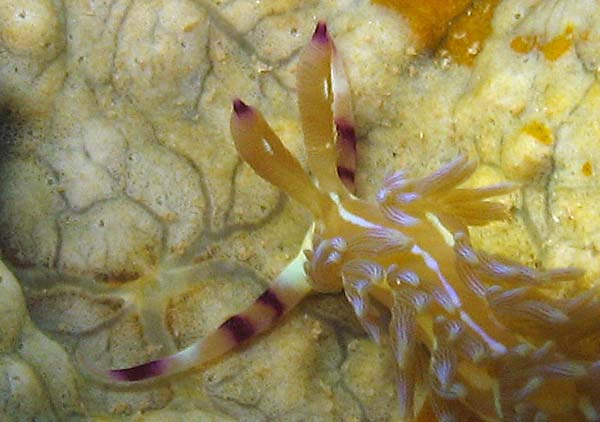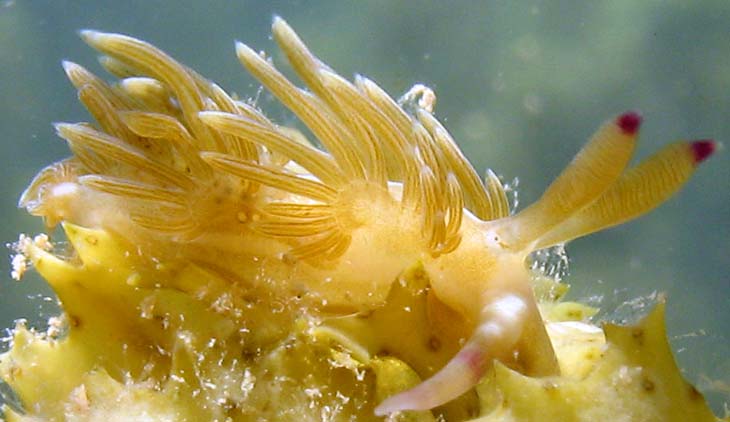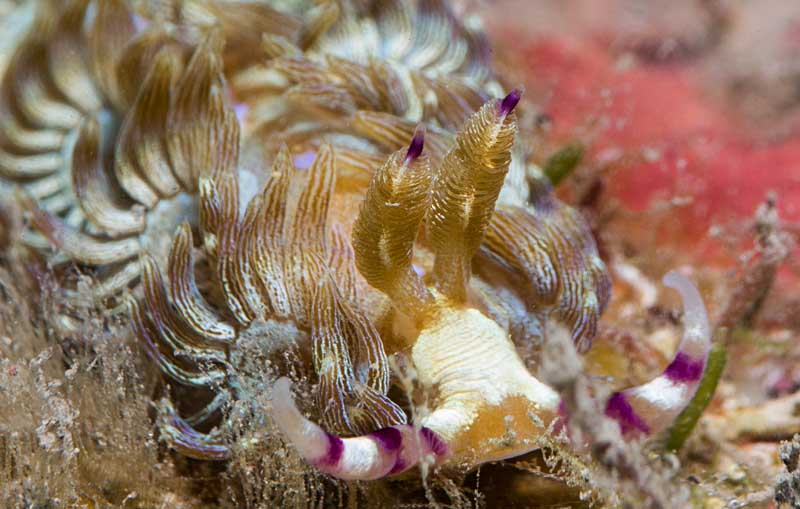This species has been observed on Reunion, Mayotte, Rodrigues, Madagascar, Seychelles
The purple bands on the oral tentacles are fairly distinctive. Elongated body shape, variable in color with differnt shades of green, blue, brown and white. Cerrata groups are disposed symmetrically along all of the body |

|
|
| Showing species characteristics... | Photo Eva Fontaine Mayotte, Mtsanga M'Titi, 2 m, 22 July 2008, size : 45-50 mm |
|
See more about : Sightening and mating periods
See more about : Pteraeolidia semperi variability in Southwest Indian ocean
See more about : Mating behavior in Pteraeolidia semperi
Remarks :
Identification confirmed by Bill Rudman
Synonymous : (according Worms)
- Flabellina scolopendrella Risbec, 1928
- Flabellina semperi Bergh, 1870
Bibliographic data :
There are two species P. semperi ( Widespread tropical Indo-Pacific) and P. ianthina ( Temperate eastern Australia), which are similar but there are some differences
P. semperi
P. ianthina
Oral tentacles with three or more purple bands , the two bands closest to the head may be very close together and partially fused
Oral tentacles with two purple bands
White markings on head, particularly anterior to rhinophores.
No white markings on head
Dorsal and lateral body typically show white vertical bars or spots
No
Cerata often show white, green or yellow and mottled markings.
Cerata relatively short in comparison to body length.
Cerata do not show white markings away from tip, although entire animal may be pale in animals lacking an active zooxanthellae symbiosis.
Cerata relatively long in comparison to body length
There is some variation in shape and colour throughout the Indo-West Pacific but there are no anatomical differences that justify to separate them into more than one species.
Adult Pteraeolidia feeding on the solitary hydroid Ralpharia which is its preferred adult food.They also seem to eat Pennaria disticha.
They are quite often found on the greyish soft-coral, Parerythropodium which forms a leathery layer over sublittoral rocks. In that case, they feed on Ralpharia which is found embedded in the soft-coral colonies.
Pteraeolidia semperi, commonly known as the "Blue Dragon" by divers in eastern Australia, is one of a group of remarkable aeolid nudibranchs which are using solar energy.
Pteraeolidia has evolved a method of capturing and farming symbiotic microscopic algae (zooxanthellae) in its own body ( in ducts of the digestive gland, in the cerata and the body wall). The zooxanthellae are able to multiply and grow within the nudibranch's tissues.
The algae flourish in this protected environment and as they convert the sun's energy into sugars, they pass a significant proportion on to the nudibranch for its own use. Adults can last some time without feeding, presumably obtaining sufficient nourishment from their "zooxanthellae gardens".
The slug's cerata are aligned and shaped to provide maximun avantage of its surface area to the sun to aid the algae in photosynthetic nutrient production
The juvenile are white animal which as not yet captured its own zooxanthellae. If this species is similar to others that have been studied then it must obtain its first "injection" of zooxanthellae by feeding on a hydroid with symbiotic zooxanthellae.
There exist an adult opaque white colour form usually associated with white coral sand or rock.
In 1999 Bill Rudman wrote :" I think that camouflage is not the sole reason for the colour pattern. I think that as with Plakobranchus ocellatus, the white pigmentation cuts down the intensity of the sunlight reaching the endosymbiotic zooxanthellae so that their plastids are not 'burnt-out' by too much sunlight and so continue to photosynthesise. It's just my pet theory and I think it would be a good little hypothesis for a physiologist to test experimentally.
I assume the white in this colour form is a skin pigment which masks the brown of the zooxanthellae, while the white of juvenile animals is caused by the absence of skin pigmentation and the absence of zooxanthellae."
References :
Bill Rudman Seaslug site : Sea Slug Forum : Pteraeolidia ianthina
Nudipixel Pteraeolidia ianthina
Publications :
Angas, G.F. (1864). Description d'espèces nouvelles appartenant à plusieurs genres de Mollusques Nudibranches des environs de Port-Jackson (Nouvelles-Galles du Sud), accompagnée de dessins faits d'après nature. Journal de Conchyliologie, 12 : 43-70.
Willan, R.C. 1989. Field observations on feeding and antagonistic behavior by Pteraeolidia semperi (Nudibranchia: Aeolidoidea). Veliger 32(2): 228-229.
Wilson N.G. & Burghardt I. (2015). Here be dragons – phylogeography of Pteraeolidia semperi (Angas, 1864) reveals multiple species of photosynthetic nudibranchs (Aeolidina: Nudibranchia). Zoological Journal of the Linnean Society. 175(1): 119-133
Other photos of Pteraeolidia semperi :
Maurice Jay Reunion, White color form found in "La Saline" lagoon, under a rock. |
 |
 |
Monika Bachel Reunion, Cap La Houssaye at Saint Paul, 27 September 2008, size : 120 mm The purple bands on the oral tentacles are fairly distinctive. Another white color form... |
 |
 |
Eva Fontaine mtsanga m'titi 2, Mayotte, on the fore reef zone of the littoral reef, 2 m, 19 July 2008, size : 30 mm. An area with numerous Tubastrea. This colour form, with fine bluish lines, is not very common, It was also observed in Japon. |
Eva Fontaine mtsanga m'titi 1, Mayotte, on the fore reef zone of the littoral reef, 2 m, 22 July 2008, size : 50 mm. This colour form, with fine bluish lines, is not very common, It was also observed in Japon. The purple bands on the oral tentacles are fairly distinctive.
|
 |
 |
Monika et Sully Bachel Reunion, La Possession, 6m, 3 January 2009, size : 40 à 70 mm 6 specimens found on the same rock |
Monika et Sully Bachel Reunion, La Possession, 6m, 3 January 2009, size : 40 à 70 mm 6 specimens found on the same rock This colour form, with fine bluish lines, is not very common, It was also observed in Japon. |
 |
 |
Philibert Bidgrain Reunion, Etang salé, on the rocky coast, less 1 m, 23 September 2009, size : 25 mm The purple bands on the oral tentacles are fairly distinctive. |
Michel Touzet Reunion, Sainte Rose, Roche à Bebert, 24 m, 11 September 2010, size : 80 mm A strange specimen with yellow marks on the dorsum |
 |
 |
Hugues Flodrops Madagascar, Nosy Tanikely, 10 m, 20 October 2010, size : 35-45 mm Cerata with a bluish base and yellowish apex... |
Eva Fontaine Mayotte, Mtsanga M'Titi Sada, less 1 m, 30 July 2010, size : 25 mm Specimen with a brown coloration on the cerata... on a brown algae... |
 |
 |
Kévin Bourdon Reunion, La Possession, 7 August 2013, size : 60 mm |
Alain-Benoît Rassat Madagascar, Nosy bé, anémone, 14 m, 18 April 2014, size : 20 mm
A strange specimen without purple mark on the top of the rhinophores
|
 |
In Nudibranches of Seychelles by Christophe Mason-Parker Observed at Beau Vallon, Mahé, size : 150 mm Under the name of P. ianthina
|
Available online on Archipelago Island
|
More photos from Indian Ocean
See more about : Pteraeolidia semperi variability in Southwest Indian ocean
See more about : Mating behavior in Pteraeolidia semperi
Reunion, Pteraeolidia semperi with fine bluish lines, at Saint Benoit, by Sully Bachel
Reunion, Pteraeolidia semperi with fine bluish lines, at Saint Leu, by Raphaël Roland Gosselin
Mayotte, Pteraeolidia semperi with fine bluish lines, by Sylvain Le Bris
Mayotte, Pteraeolidia semperi with fine bluish lines, at Petite Terre, by Olivier Police
Rodrigues, Pteraeolidia semperi with fine pale bluish lines, by Rachel Lebatard